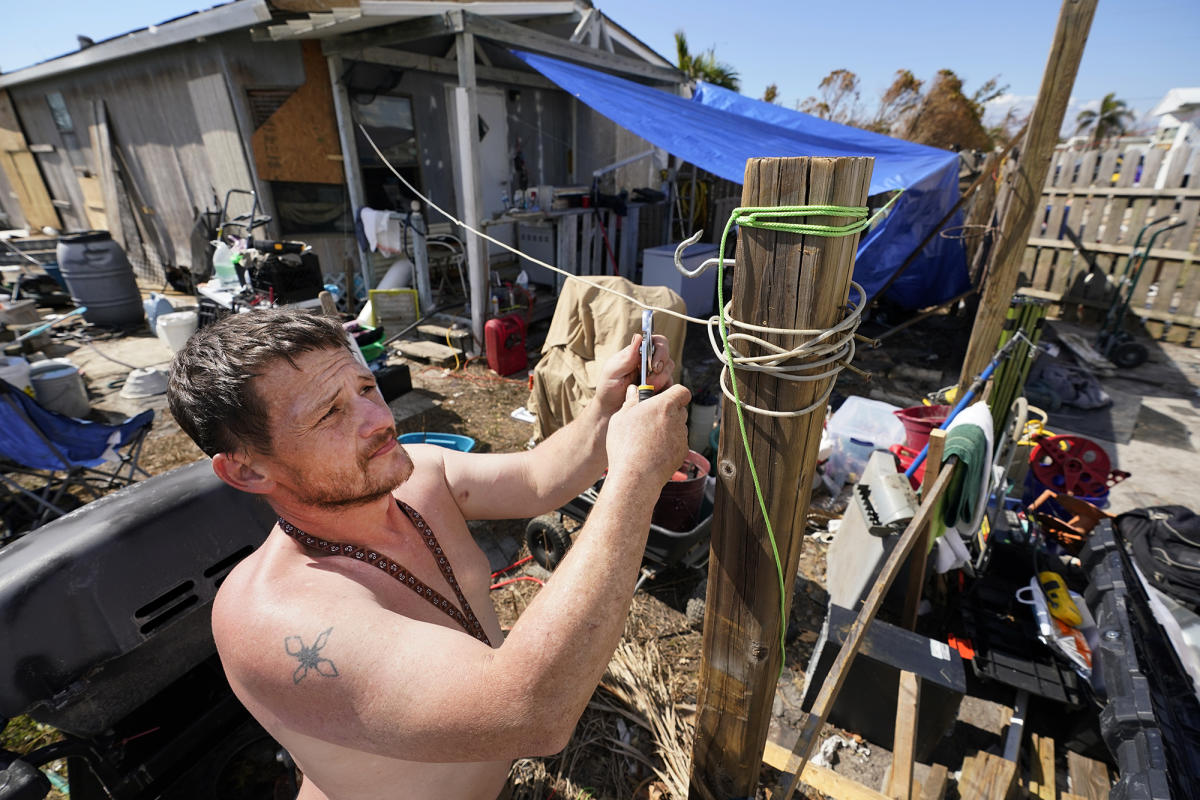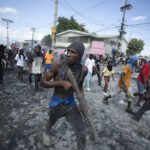
FORT MYERS, Fla. (AP) — With her home gone and all her belongings trashed by Hurricane Ian, Alice Pujols wept as she picked through soggy clothes, toys and overturned furniture piled head-high outside a stranger’s house, looking to salvage something — anything — for her four children and herself.
“I’m trying to make it to the next day,” she said. “That’s all I can do. It’s really depressing. It really is.”
For those who lost everything to a natural disaster and even those spared, the anguish can be crushing to return home to find so much gone. Grief can run the gamut from frequent tears to utter despair. Two men in their 70s even took their own lives after viewing their losses, said the medical examiner in Lee County, where Ian first made landfall in southwestern Florida.
The emotional toll in the days, weeks and months after a hurricane, flood or wildfire can be crippling. More pressing needs for food, shelter and clothing often take priority to seeking counseling, which is in short supply even in good times.
“When someone’s in a state of trauma that so many are in, they don’t know where to begin,” said Beth Hatch, CEO of the Collier County, Florida, branch of the National Alliance of Mental Illness. “They need that hand-holding and they need to know that there’s so many people here to help them.”
Hurricane Ian hammered Florida with such ferocity that it wiped out whole neighborhoods, tossed boats onto highways, swept away beaches and swamped homes in roof-deep waters.
With sustained winds of 150 mph (240 kph), it was one of the strongest hurricanes to ever hit southwest Florida. It later cut a watery and wind-battered swath across the Florida peninsula before turning out to sea to regain strength and pummel South Carolina.
It killed more than 100 people, the majority of victims in Florida, making it the third-deadliest storm to hit the U.S. mainland this century. Even a week after it passed through, officials warned that more victims could yet be found as they continued to inspect the damage. The storm knocked out power to 2.6 million and caused billions of dollars in damage.
Research has shown that between a third and half of those who survive a disaster develop some type of mental distress, said Jennifer Horney, an epidemiology professor at the University of Delaware who studies natural disaster impacts on public health.
Post-traumatic stress disorder, depression and anxiety rise along with substance abuse. Those with existing mental disorders are at greater risk of having those conditions exacerbated by the trauma.
A variety of help is available as additional resources are sent to the area.
The state of Florida was setting up support centers and the federal government has a 24-hour disaster distress helpline to provide counseling and crisis support. Hatch’s organization was going to some homes in hard-hit areas to check on clients with mental illness.
The vast majority of people, though, were still assessing damage, trying to retrieve and dry out possessions worth keeping and drag what couldn’t be saved to growing trash heaps by the side of the road.
On Pine Island, just off the Florida mainland where Ian first struck, an emotional Alan Bickford said he was trying to take a longer view because what lay before him was bleak: the floors of his home were coated in stinky muck and his yard was littered with framed photos, furniture and other items he’d hauled outside.
“It’s like a death of a loved one. The pain just comes and goes,” he said. “There’s times when there are these little glimmers or slivers of hope. And then everything falls apart.”
Riding out a deadly storm amid screaming winds, pounding waves and rising waters, or escaping as danger closes in is terrifying and traumatic. Living out of a duffel bag or suitcase in an evacuation center is disruptive, stressful and depressing. Returning to a flood-ravaged home that needs to be gutted to prevent mold from taking hold or, worse, reduced to splinters and scrap metal and scattered like confetti is heartbreaking.
Mao Lin walked an hour Thursday to reach the plot of land where she had lived on Fort Myers Beach, which looked like a blast zone. She was distressed to find it gone.
“The whole street — nothing’s left,” she said. “We don’t have a home. We don’t have a car. We don’t have anything. We have nothing left.”
In recent days, the number of calls have doubled at Hatch’s organization as people recognize they cannot rebuild their lives — and overcome trauma — alone.
“The needs are going to change over time,” Hatch said. “Some people have lost everything, maybe the walls of their home may be still standing, but they’re uninhabitable.”
Cleaning up the mess of a damaged home or finding a new one in the wake of a catastrophe gives way to the longer term challenges of navigating the maze of bureaucracy for financial assistance, securing permits for rebuilding or fighting insurance companies over reimbursements.
Horney studied suicide rates in counties that experienced a disaster between 2003-2015. She and her colleagues found suicides increased 23% when comparing the three-year period preceding a disaster to the three years after an event, according to the study published in The Journal of Crisis Intervention and Suicide Prevention.
She said the Sept. 30 and Oct. 1 suicides of men in their 70s was not typical so soon after a catastrophic event.
“It’s not usually an immediate, post-disaster thing,” Horney said. “It’s really these longer-term mental health problems that have either been exacerbated by or caused by the disaster that then over time tend to lead to more severe outcomes like suicide.”
In the aftermath of a disaster, communities pull together to recover and rebuild. Rescuers, relief workers and nonprofit organizations provide food, funding and other help, including counseling. But attention eventually fades and the money dries up. Emergency funds for mental health sometimes expire in as soon as two months and last no longer than a year.
With disasters becoming more frequent and more severe due to climate change, there could be a cumulative effect on mental health, Horney said. She said her study calls for more funding to fix the damage that is felt but can’t be seen.
Most of the emotional impacts of a disaster are short-lived but they could be worsened if followed by another cataclysmic event.
“If it was usual that symptoms would resolve in six months to a year, but then there’s another hurricane or another wildfire, then you’re in this cycle of intensifying mental health impacts,” Horney said. “The research is definitely clear that the more disasters you’re exposed to, the stronger the impacts on mental health.”
Joe Kuczko hunkered down with his parents as their Pine Island mobile home was battered by the storm. Kuczko got a gash in his foot that he stitched himself after a piece of the roof blew off.
Pieces of mangled metal lay on the ground Thursday along with containers full of possessions and clothes hung to dry as Kuczko, shirtless and with a sunburn on his back, strung up a tarp to keep the rain out of what remained of the home.
“I lost the first 30 years of my life,” he said. “Every time I hear the wind blow and a piece of aluminum shift, it’s like PTSD.”
___
Melley reported from Los Angeles. Associated Press journalist Robert Bumsted contributed to this story from Pine Island, Florida.
___
The National Suicide Prevention Lifeline is available for those in distress by dialing 988 or 1-800-273-8255.




